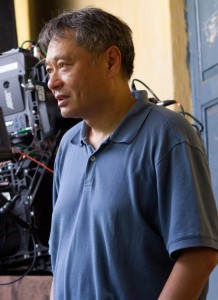Directors should learn from Lee
At the beginning of the semester I wrote about auteurship, arguing that filmmakers need to strike a balance between mindless entertainment and films that are intentionally artistic.

Diverse directing · Ang Lee directs a scene for Life of Pi. His credits also include Brokeback Mountain and Crouching Tiger, Hidden Dragon. – | Photo by Jake Netter, courtesy of 20th Century Fox
I argued that filmmakers need to find their identity — one that is recognizable as that of their own — so their work is distinct.
Ang Lee’s career, as a whole, has encouraged me to revise the way I understand auteurship, and what it means for filmmakers to have their own specific identity as artists.
Lee does not perpetuate one particular style. Instead, he stands as a testament for what filmmaking should be — versatile.
Lee doesn’t represent any one thing, but that’s exactly what defines him. And if auteurship is about creating your own specific identity, then Lee’s identity is versatility.
Just look at some of his most famous films.
Crouching Tiger, Hidden Dragon was a beautiful presentation of martial arts set in lush, stunning Asian backdrops. Hulk served as Lee’s chance to explore the action-adventure flick. Brokeback Mountain was a quiet drama in which Lee pushed narrative boundaries with a romance between two gay cowboys and was full of beautiful cinematography. Now, with this year’s Life of Pi, Lee has pushed himself with technology, using 3-D to add depth and dimension to his gorgeous work.
Though each film has its own individual flair, be it through its narrative or innovative use of technology, they are all stunningly beautiful. And though they are all well shot, each of Lee’s films are vastly different from each other, showing his ability to push himself out of his comfort zone.
Lee’s drive to innovate is exactly what Hollywood needs in filmmaking today.
This isn’t to say artists shouldn’t carry a personal style. Having a recognizable style of your own is great, of course, and it gives filmmakers a voice to call their own.
It’s safe to say that most filmgoers could smell a Quentin Tarantino or Joe Wright film from a mile away, simply because their works are that identifiable.
Tarantino engages with vastly different subjects — Nazis (and Nazi killers), slaves and assassins, to name a few — but he has made a name for himself with his quick wit and mash-up technique that compiles a series of styles into a single film. Wright, on the other hand, has made a career out of lavish, dramatic period pieces — cue Pride & Prejudice, Atonement and now Anna Karenina.
But creativity really flourishes when creative boundaries are pushed and a new set of eyes are applied to a genre or style.
Martin Scorsese, for instance, received rave reviews from critics and Oscar attention when he branched out of his crime-drama norm and experimented with a quirky children’s film, Hugo.
And now we have Ben Affleck. The triple-threat talent directed two Boston-based films, Gone Baby Gone and The Town. For Affleck, a Boston native, these films spoke to his experiences. Then, this year’s Argo came out, a film about the 1979 Iranian hostage crisis — quite a long way from Boston — and his popularity soared. Affleck, as actor, producer and director, went out of his comfort zone. The result: His period drama has been popularly and critically received as a refreshing and exciting political thriller that was well-acted and well-directed.
With certain filmmakers, you know what you’re going to get. And while that might be comforting because you’re more likely to enjoy a film, most people probably won’t want to see a re-creation — a near exact replica — of what has already been done before.
With awards season on the horizon, the film landscape seems to be flourishing: Silver Linings Playbook, Life of Pi, Hitchcock, Lincoln, Argo and so on.
Looking beyond the fall and winter wealth spring of great films, however, filmmaking could afford to be more dynamic. Yes, we had Moonrise Kingdom and Beasts of the Southern Wild premiering in the pre-Oscar season, but we also had Wrath of the Titans and (please, no more Katherine Heigl) One for the Money.
It takes an ambitious, driven and creative director to churn out dynamic films. But capable filmmakers need to push themselves to be more versatile so that their work becomes more creative as a result. Versatility should be the standard and not the exception to the norm; innovation is what we should seek. That being the case, filmmakers follow Lee’s example.
C. Molly Smith is a junior majoring in communication. Her column “Keepin’ it Reel” runs Wednesdays.

I have learned a lot from this article, too. Thank you.